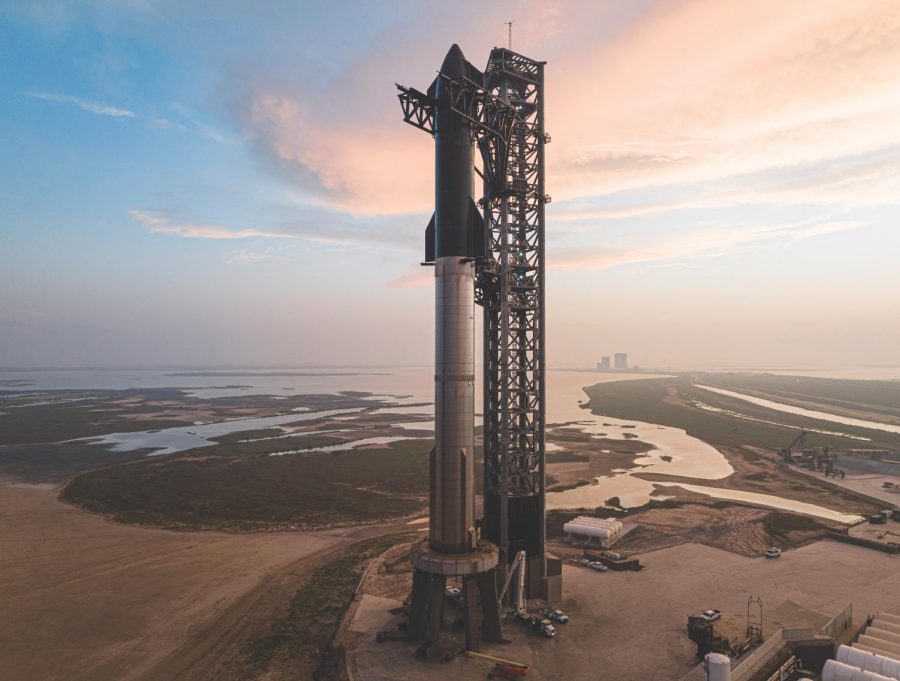SpaceX develops Starship, rocket created to make intergalactic travel possible
July 11, 2023
Space Exploration Technologies Corporation launched its Starship rocket on the morning of April 20. Flames followed in its wake as it soared into the air. But four minutes in, it tumbled out of control and exploded.
Plans for a heavy-lift rocket have been in place since 2005, with its ultimate goal being multi-planetary colonization.
The rocket, at 394 feet tall with 33 firing engines, is the most powerful space vehicle ever flown. Its predecessor, Falcon Heavy, is the second most powerful space vehicle with 27 engines and half the liftoff capacity.
The rocket exploded during its inaugural launch while attempting to detach from its two components, otherwise known as stages. Mechanical engineer and 2018 Paly alumnus Jacob Zajac shines more light on the different components, or stages, of the rocket.
“The rocket starts on the launchpad fully loaded up with fuel. At ‘liftoff’ the first stage ignites and carries the rocket up through the atmosphere,” Zajac said. “Then the first stage runs out of fuel and the second stage, which sits on top of the first, detaches. The second stage ignites and brings the payload into space.”
Having exploded quickly after its launch, Starship was 150 miles short of its intended altitude. A tornado of debris was launched into the air when it took off.
“If you look at some of the pictures of the launch pad that were posted on Twitter, there’s a giant crater that formed below it,” former SpaceX intern and 2018 Paly alumnus Devin Ardeshna said. “All that debris had to go somewhere, and you can see some of it raining into the sea during the launch. Three engines were gone as soon as the rocket took off, so I think there’s a good chance some concrete pieces just hit those engines and killed them.”
Following the launch, Starship tumbled out of control shortly before SpaceX called for it to self-destruct. Ardeshna said that some suspect the hydraulic pressure unit, which is supposed to send pressure to the engine’s gimbal — a device that keeps the rocket oriented correctly.
“There was also an explosion right above the engines part of the way through the launch,” Ardeshna said. “Some people are saying it was related to a hydraulic pressure unit which would control the engine’s gimbal. Eventually the rocket lost control and started spinning.”
Regardless, Ardeshna said it was impressive to see the rocket stay together before it exploded
Aerospace and Robotics Club Co-President and junior Mike Song said he thinks the launch achieved its purpose of testing boosters.
“The point of this launch was to prove the concept of the boosters as well as getting the rocket to take off and clear the launch pad,” Song said. “It did all of that, so all the major goals were accomplished through this launch.”
Boosters are essential for SpaceX’s goals.
“A booster is a rocket whose job is to give something a boost into orbit,” Zajac said. “It takes a lot of fuel to get through Earth’s atmosphere, but maneuvering in space is relatively easy, so the booster is designed with big engines and lots of room for fuel to take care of the first step.”
While some may have wanted Starship to work perfectly, Ardeshna said it was only a hope and not an expectation.
“I don’t think anyone at SpaceX expected this launch to work perfectly,” Ardeshna said. “It’s better to blow up a rocket and analyze the data to figure out what you need to do differently because otherwise, you’re just guessing what the problems are going to be because there is so much that’s unknown.”
Though the launch was unsuccessful, Ardeshna said SpaceX’s technology has improved significantly.
“We actually stopped one of the robotics competitions sophomore year to watch a Falcon 9 launch because they were somewhat novel back then,” Ardeshna said. “Now, they’re on track to have 100 Falcon 9/Falcon Heavy launches a year.”
However, Ardeshna said there are still issues to work through, especially with the cost of resources.
“Right now it is so expensive to send things into orbit,” Ardeshna said. “Starship is targeting a 10-100 times reduction in cost, which would be game changing.”
The ultimate goal SpaceX CEO Elon Musk has in mind for the SpaceX rockets is to allow humans to inhabit other planets.
The rocket is not the only thing preventing Musk from achieving his goals.
“It takes so much beyond a capable rocket to start a colony on another planet,” Ardeshna said. “You need to find a way to protect people from radiation during the trip and on the planet, construct a habitat and make it self-sustaining.”
While Song said SpaceX may not be able to achieve that particular goal, Starship has a lot of potential to reach its inter-planetary goals.
“I don’t know if (Musk) is going to Mars, but I think the rocket has lots of potential and can go to the moon and farther,” Song said.
Regardless, Ardeshna said SpaceX’s rapid trial-and-error process allows them to reach ever closer to achieving the goal of multiplanetary habitation.
“If you look at Falcon it took a few failures to get things working too,” Ardeshna said. “That is the SpaceX way: continue blowing up rockets until everything works.”







